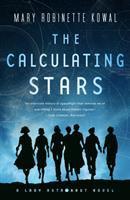
One of my personal reading goals I set when Covid-19 first started turning things upside down was to read more of the books on my own personal shelves, things I'd bought but not read yet. I wasn't counting on my reading mojo plummeting, and truthfully, as far as timing went, I might have chosen a bit more wisely than to read a book that begins with a cataclysmic event that will likely be a human extinction event in time. So while I was fairly certain I would ultimately enjoy Mary Robinette Kowal’s The Calculating Stars, first book in her Lady Astronaut series, it took a bit for me to fully immerse in it, but I'm glad I stuck with it.
Kowal is one of my favorite authors, known for typically blending some element of history (Regency-era England in her Glamourist History series, WWI in Ghost Talkers) with speculative fiction, often fantasy but in this case, science fiction. The Lady Astronaut series is set in an alternate 1950s, beginning with a meteorite striking the east coast of the United States. This strike sets into motion a series of changes that will speed up climate change and inevitably make earth inhospitable to human life, unless humanity can speed up its space research and make it to the moon. Protagonist Elma York's background as a mathematician and former Women Airforce Service Pilot (WASP) married to an engineer uniquely positions her to be a part of the International Aerospace Coalition, but this is the 1950s, and like our own timeline, the glass ceiling and discrimination are real. The story follows the overall race to get to space against a ticking clock alongside Elma’s growing realization that she wants a chance to see the stars herself and advocacy for women in general to be part of that pivotal moment.
The Calculating Stars worked on a couple different levels for me, both worldbuilding and characters. The world felt convincing--a lot like our own, with noticeable differences. I think my favorite change was that the U.S. capitol moved to Kansas City, KS since Washington D.C. was destroyed by the meteorite. We don't often get to see our state in fiction, much less beyond a place that a character wants to escape from, so it was a delightful bit of Midwest representation. One character even mentions crossing the state line and getting to see the Midland Theatre. Fun stuff! The world at large also feels convincing, though, with a variety of responses to the post-meteor reality. The impending doom is approaching fast enough to be alarming to those watching the science but slow enough that the space program is afraid of losing public support for the urgency of space flight as the meteor disappears from people's recent memories and awareness. It was a little on the nose for current reading, but science fiction as a genre is good at engaging with those timeless issues of human nature.
The other aspect that worked for me was the characterization. Elma is a sympathetic protagonist, highly competent at what she does but held back at times by crippling anxiety. Her journey is one of both fighting for recognition as an equal to her male counterparts as well as getting help with the anxiety itself and learning not to see it as a personal liability. When she ends up being the unwitting face of a movement to allow women to join the astronaut corps, it pushes her in challenging directions, but she rises to the occasion. I also really appreciated the dynamic between her and her husband Nathaniel, who is just as competent and important to events as she is and even better yet, is fully supportive of his wife even when it goes against pressure from above. They also clearly enjoy the physical aspect of their marriage, depicted through non-graphic, innuendo-filled bantering scenes about rocket launches and the like, which were slightly cheesy but cute. I know unhappy relationships make for more dramatic literary fare, but give me a happy couple in love over a miserable one any day, especially when the very fate of the world looms heavy in the background. Elma and Nathaniel are also practicing Jews, which adds another layer to them and provides further opportunities for facing microaggressions, but it also doesn't prevent them from their own blunders against other minorities. Elma has to confront her blind spots at multiple times, learning from the incidents and most importantly apologizing when she messes up.
Overall, it was a satisfying blend of crunchy harder sci fi (Kowal put in a ton of research with NASA, and it shows) with the softer, human side that I like in my science fiction. Among the many disappointments of Covid-19, Mary Robinette Kowal was originally scheduled to come to Kansas City this month for both a local science fiction convention and a series of library programs here at JCL. While we can’t show off our Midwest hospitality at this time, we are still hosting a virtual program with her on Thursday, May 21 at 5:30 p.m. about her research process, featuring her interviewing local professor Allison Kirkpatrick about astronomy and women in STEM. Registration is open until May 20 at 5:30 p.m.
